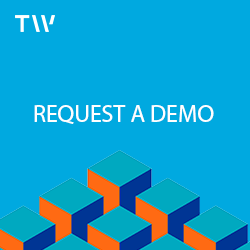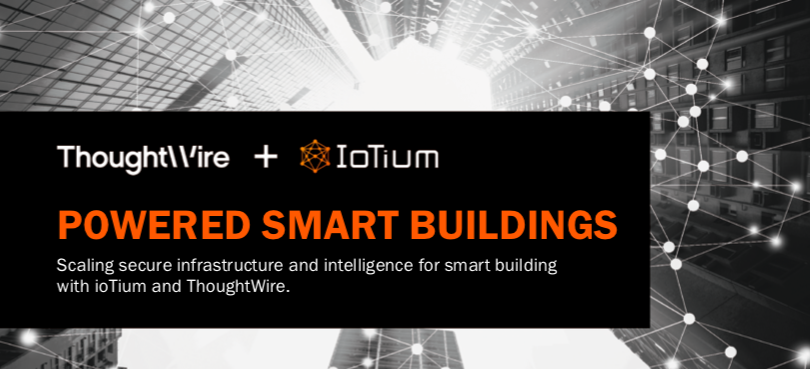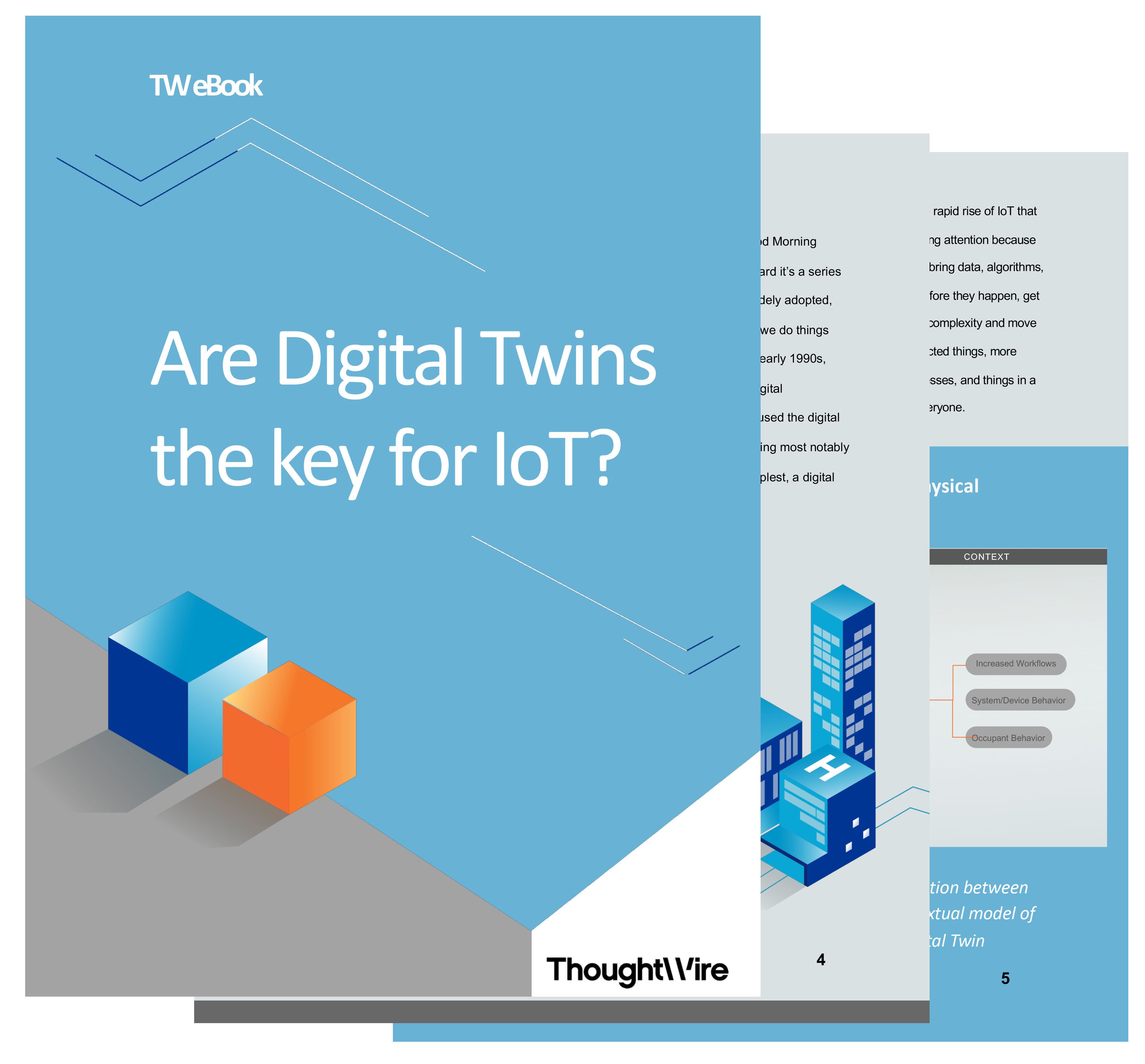Recently, we hosted our expert webinar with ioTium, the first commercially deployed Software-Defined Converged Infrastructure company for the Industrial Internet of Things (IIoT). Watch the full webinar here to learn how ioTium and ThoughtWire's solutions can enable you to connect and automate your building, technology and energy systems to transform the way you manage your facility. By connecting to these systems, streamlining your operations, you can reduce operating costs, improve occupancy services and minimize security risks.
Below is a transcription of Ganesh Ramamoorthy (VP of Business Development, ioTium) and ThoughtWire's CCO, Franco Castaldini Q&A session.
Q: What goes into becoming an edge partner like ThoughtWire?
A: Ganesh: The ecosystem itself, and as you know just like ThoughtWire, what we are essentially trying to do is to offer a plethora of services of different types of functionality. What we need to make your app available in the ioTium marketplace starts by interfacing with me or somebody on my team and we walk you through how we do things and how we like to get a version of your software that will be available for download. What we also go through is the process of licensing, because we typically don't get involved in licensing of your software. So what we have is the pathway for customers to license their software and then subsequently have the software available on the iNodes for execution.
Q: How simple is it to deploy an edge application like ThoughtWire’s to ioTium’s infrastructure and what does that implementation look like?
A: Ganesh: The beauty of what we offer, one of the three tenets and what ioTium prides itself on is the notion of future-proofing deployments. What I mean by that is the iNode itself is capable of running applications of the edge and as a result what happens is let's say a customer decides today that they want to run application A. It's a simple matter of just telling us where that application resides. We then deploy that application at scale to all the iNodes at the customer location and you're off in terms of execution. Tomorrow if you feel that the needs of the business are changing and you want to either download a new application or go in a completely different direction. It's a simple matter of allowing us access to the application from ThoughtWire, or whoever the partner is in terms of the specific needs of the customer. Then it's a matter of downloading the application down to the different iNodes and you're off and running. So the implementation itself is not having a bunch of consultants coming in and doing a bunch of stuff. It's literally a matter of telling us where the application resides, whether it's a homegrown application whether it's a custom application that's available through our app ecosystem. Whatever the application, we literally just point to it and voila one keystroke later the application arrives at the iNode and ready for execution.
Q: You mentioned a case study with a joint customer between ThoughtWire and ioTium, is this a solution that was deployed in a new construction building or an existing asset or building?
A: Franco: It was a retrofit of an existing building, however that being said some of the systems had to be updated in order for the fine-grain control of what we provide to be deployed. That allowed us to get more granular with the zoning of the building and once those infrastructure improvements were made, we deployed the ioTium iNode and deployed PrecisionHub Edge to the building and it allowed us to capture the data and begin to control those systems.
Q: A question for both teams: Are you agnostic through your software stack?
A: Franco: Yes agnostic in terms of the systems that we integrate with absolutely. We handle data integration first at the protocol layer, which allows us to tackle protocols like BACnet and Modbus, telnet, SMTP, Restful as some of the common ones that we come across and any kind of data mapping from source systems to our data model, which is the Digital Twin. Either something that we've come across and we've done before and therefore there's no configuration necessary. If it's a new system that we haven't come across then there's some level of configuration that takes place at the time of deployment.
A: Ganesh: We are also fairly agnostic in the sense that we pride ourselves in one simple thing. You know we are able to connect any application or any device to any application of the crowd, across any infrastructure or communication protocol in between so as a result, no matter what the devices and where the data needs to be taken to, we are able to facilitate that in a very simple fashion and more importantly the very secure manner. And that data, once it is captured, is what ThoughtWire’s service acts on.
Q: What lower stack protocols does ioTium have to connect with end node sensors like occupancy light sound sensors, Zigbee, BLE, 6lowpan, etc?
A: Ganesh: I think all of those that are called out are something that we can facilitate with as Bluetooth, low energy, Zigbee doesn't matter what the protocol is, and this is the point I was trying to make in my earlier statement. Where you can connect literally any device to any application in the cloud across any communication protocol that's the beauty of our solution. I wouldn't necessarily say that we do it all ourselves, because some of these things in terms of translation has been done by multiple companies and so many of these things especially in the data transfer protocols, we use libraries from third parties, but we are fairly consistent in that any of those protocols are supported by us.
Q: Many smaller companies would not have the advanced infrastructure that you displayed earlier with an existing data warehouse or data lake, that would be available to consolidate the data from multiple sources. Is that data warehouse offered as part of your implementation process or do companies need to update their infrastructure prior to the ioTium iNodes being deployed?
A: Ganesh: It doesn't have to be an existing data warehouse per se, but the companies obviously will have some idea as to where they want the data to reside. I think that's more important. Once they decide as to where the data that's coming in from whatever devices that have been connected, then it's a matter of simply saying okay, you know send along an iNode, load the appropriate application for the iNode, extract the data. The beauty of the solution itself is that the topology for the interconnection is very flexible. What that does is you're able to change the topology on a moment's notice, but the customer has to have some ideas where the data has to go to but doesn't have to have a built-in capability around what our data warehousing skin looks like, but that's something that can be added along, as long as they have some kind of repository.
A: Franco: Adding to that answer, as part of our deployment, we provide a Digital Twin. What that is giving you, is the ability to organize the data in support of the applications that we offer PrecisionHub and @WorkApp. So it is a database, in particular, a graph database, it's storing the data in real-time for those applications and then if you would like to, you could persist the data for longer-term analysis in storage to a data warehouse or data lake. That data warehouse we could be deployed to is either in the cloud or if you prefer you could do it on-premises as well. So that's value-add that you get with the ThoughtWire offering, a Digital Twin, which is organizing the data, modeling it for you prior to you storing it to your data warehouse.
Q: What is an iNode exactly. Is it a hypervisor a server or controller or something else?
A: Ganesh: So the iNode itself comes in two incarnations. One is the physical iNode and think of this one as literally a commercial off-the-shelf device like a Dell 5000 box or a box from Advantech or D-Link or whoever. We support a number of these devices. The basic difference in these different devices is that depending on what kind of connectivity that's needed from the Edge is the devices from which you're trying to extract data from what kind of connectivity is needed. You choose the appropriate device. Whether it’s an rs-232. Rs-485 BACnet OPC PLC whatever the connectivity. You choose the appropriate device - that's the physical iNode. Then we put a very thin hardened Linux kernel on that iNode and that device is shipped to the customer. In some instances, customers already have compute capability at the edge. So in those cases rather than having yet another device shipped to the customer, they use a VM instance of the iNode, rather than shipping any device, you just download a VM instance of the iNode and the functionality is the same as the physical one.
Q: Can you talk a little bit about the security of the ioTium iNode and how it's benefiting asset owners?
A: Ganesh: So when Janet walked us through the demo, she talked about a skill data plane that is established. So once we know where the data is coming from and where the data is going to, we create a secure data plane between that source and destination. All that data is encrypted and then transferred across the skill data plane. When you have multiple streams because multiple sources going to multiple destinations, each of these also have their own secure data plane, which means that there is no overlap of data transmission, they each have their own panel. So there's the security built into each data plane, as well as security built across multiple communication channels. So everything is a secure data stream in itself.
The other thing I want to point out is that we continuously work with third parties who do penetration testing of the software, and so they are constantly looking out to see how we can hack into the system and we are working with them on an ongoing basis to make sure that the software is secure and cannot be hacked . Should vulnerabilities surface from those penetration tests, we come back, make fixes and make sure that the product is robust enough for the customer's needs.
Q: We hear a lot about digital twins recently. What is the benefit of a digital twin approach versus a data lake or doing analytics on that data once it is normalized in the data warehouse?
A: Franco: A Digital Twin turns data into operational value whereas a data warehouse is going to retain your data which then further requires you to mine it analyze it to gain value out of it. Our Digital Twin not only organizes the data but then starts to support the process orchestration and closed-loop communication and complex event processing required to drive the outcomes that you want. So if you want to improve workplace experience by having a mobile application that reduces the friction between you and your building operations, a digital twin is going to be key in managing those workloads between the occupant and the operator. So that's what we mean by operational value, it’s really centered around putting data into the hands of the people, into the hands of the right people at the right time at the moment when it counts most. In buildings where the expectations are growing in terms of what they should provide in amenities and experience and how your people should be able to use space, there are all sorts of use cases that tie into it, and you need to have that strong foundation and that's the Digital Twin.
Want to learn more? Schedule a demo to see how ThoughtWire’s smart building suite can help you transform your space and keep ahead of the competition.





